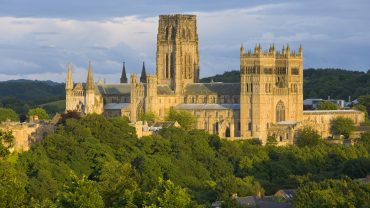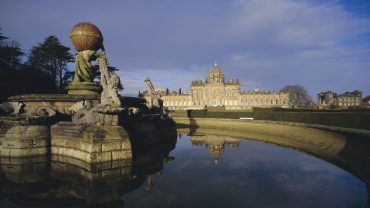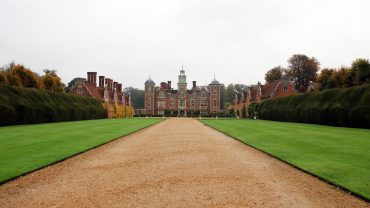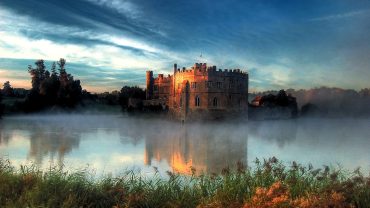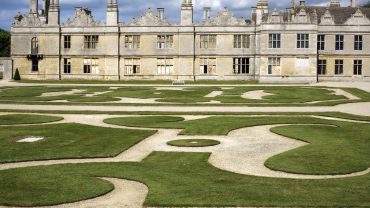This most elegant of architectural movements shaped the aesthetic and cultural identity of the United Kingdom, and emerged as the nation transitioned from tumultuous times to become a global power.
This period marked a time of urban growth and the development of elegant new towns and cities. Bath, Edinburgh, Liverpool, London, the northside of Dublin, and to a lesser extent Bristol and York, embraced Georgian era architecture. It saw the construction of stately squares, terraces, and civic buildings, each reflecting the grace and order that came to define the style.
Here, we’ll take an in-depth look at Georgian architecture, its origins and characteristics, as well as discovering the era’s prominent architects and the nation’s most famous Georgian houses.
The Roots of Georgian Era Architecture

Palladio drew inspiration from the 2,000 year-old Pantheon in Rome (Credit: Achim Thomae via Getty Images)
The Georgian style drew inspiration from Renaissance architecture, particularly the works of sixteenth century Venetian architect Andrea Palladio, and evolved from the staggeringly opulent, almost theatrical, Baroque period. Georgian architecture was profoundly influenced by Palladio’s work, which itself drew inspiration from the classical architecture of ancient Greece and Rome which emphasised symmetry, proportion, and mathematical ratios. It often featured temple fronts, deep porticos, and harmonious proportions inspired by Roman structures such as the Pantheon and Portico di Ottavia.
The Grand Tour, a rite of passage for many young British aristocrats which gave them the opportunity to learn about European art, language, literature and culture, also played a crucial role in shaping the aesthetic of Georgian architecture homes and buildings. These flamboyant travellers brought back artistic and architectural influences from their journeys to Paris, Rome, Florence, Geneva, Vienna, Berlin and Athens, and it was this cultural exchange that facilitated bold architectural experimentation, and helped to enrich the nation’s artistic and architectural scene.
The Characteristics of Georgian Era Architecture

The beautiful Georgian facades in London's Bedford Square (Credit: tupungato via Getty Images)
The architecture of the Georgian period is generally characterised by its simplicity, symmetry, and emphasis on proportion. Yet while the overall design ideals remained consistent, the Georgian period spanned 116 years, and the style subtly shifted to adapt to societal needs, fashions, trends, and preferences.
Early Georgian architecture homes usually featured plain facades with minimal ornamentation, while later iterations incorporated more decorative elements, particularly inside, where plasterwork and decorative motifs grew increasingly elaborate. These subsequent transitions were influenced by the later short-lived Regency style which lasted until the start of Queen Victoria’s reign in the late 1830s.
At the start of the eighteenth century, Georgian architecture typically employed uniform materials such as red brick or stone, with centrally placed front doors, symmetrical chimneys and room layouts, and large sash windows which were often exactly three times their width. An interesting quirk of Georgian architecture homes was that the ground and first floors, where the family lived, had very high ceilings, but the ceilings on the second and third floors, usually the servants quarters, were much shorter.
As the century progressed, the fashion for elegant white or cream-painted stucco took hold which lent a refined uniformity to terraces and squares all over the country. Despite the various changes over the years, the hallmarks of Georgian era architecture, including a consistent use of mathematical proportions, and classical motifs like pediments and columns, remained ever-present.
The Most Prominent Figures in Georgian Architecture

Robert Adam's Charlotte Square in Edinburgh (Credit: benedek via Getty Images)
Several architects played transformative roles in shaping Georgian architecture homes and buildings, leaving behind a legacy of iconic buildings and urban planning that defined the elegance and symmetry of the era.
William Kent (1685 – 1748)
Kent was a pioneer of the Palladian style in Britain, introducing classical principles inspired by Palladio and Inigo Jones. His crowning achievement, Holkham Hall in Norfolk, completed around 1764, is one of the most famous Georgian houses in the UK and is a perfect example of his mastery of the proportion and grandeur of Georgian era architecture. Kent also contributed to landscape design, as a pioneering figure in the development of the English landscape garden. His influence extended beyond architecture to furniture, sculpture, and interior design.
Robert Adam (1728 – 1792)
The son of William Adam, one of Scotland’s most renowned architects, Robert revolutionised Georgian architecture, blending Palladianism with lighter, more decorative elements. His work on Kenwood House in north London and Osterley Park in west London showcased pastel palettes and intricate plasterwork as well as developing the principle of movement by creating vastly different room sizes and decorative schemes. Adam also contributed to urban planning, designing Charlotte Square in Edinburgh and Apsley House in London.
John Nash (1752 – 1835)
One of the most famous British architects of any era, Nash dominated late Georgian architecture. His most iconic projects include the Royal Pavilion in Brighton, Regent Street and Regent’s Park in London, and major work on Buckingham Palace, not only one of the most famous Georgian houses in the UK, but one of the most instantly recognisable buildings in the world. He introduced asymmetry into domestic architecture with Cronkhill in Shropshire, one of the first Italianate villas. Nash’s urban planning transformed London’s cityscape, creating harmonious crescents and terraces for the emerging middle class.
John Wood the Elder (1704 – 1754) & John Wood the Younger (1728 – 1782)
This father-son duo shaped Bath’s architectural identity with masterpieces like The Circus and Royal Crescent. Their designs integrated classical proportions with the city’s natural landscape, establishing Bath as a showcase of Georgian elegance.
Influential Georgian Architects

James Gibbs' iconic Radcliffe Camera in Oxford (Credit: SilvanBachmann via Getty Images)
Other influential figures in the era of Georgian architecture include Colen Campbell, author of Vitruvius Britannicus, who helped transition English architecture from Baroque to Palladian. Richard Boyle, 3rd Earl of Burlington was responsible for Burlington House on Piccadilly, and James Gibbs, who bridged Baroque and Georgian styles with iconic buildings such as Oxford University’s Radcliffe Camera, and the church of St Martin-in-the-Fields in Trafalgar Square.
Isaac Ware was a protégé of Richard Boyle and went on to design Wrotham Park in Hertfordshire and Clifton Hill House in Bristol. Henry Flitcroft, once the Surveyor of the Fabric of St Paul’s Cathedral, built Bower House in Essex in 1729 as his first commission, as well as Woburn Abbey in Bedfordshire between 1748 and 1761. He also contributed to the Georgian aesthetic in London, with major works on the church of St Giles in the Fields in Holborn, the Foundling Hospital Chapel in Bloomsbury, and on the Bedford Estate encompassing much of Bloomsbury and Covent Garden.
Venetian architect Giacomo Leoni brought Italian Renaissance influences to England with works including Queensberry House in Mayfair, one of the first London mansions with an antique temple front, and Moor Park, the stunning Neo-Palladian mansion in Hertfordshire, one of the most famous Georgian houses in England. Later architects like Sir John Soane, known for his innovative use of light in buildings like Dulwich Picture Gallery, further refined the aesthetics of Georgian era architecture.
Collectively, these architects shaped not only individual buildings but entire urban landscapes across Britain. Their contributions to Georgian architecture ranged from grand country estates to modest townhouses, crescents, squares, and public institutions.
Georgian Architecture: A Grand Finale

Regent Street in London, a stunning example of Georgian architecture (Credit: Alexander Spatari via Getty Images)
Georgian era architecture embodies the elegance and refinement of a bygone era, its enduring legacy a testament to the timeless appeal of classical design principles. From the symmetrical facades of Georgian townhouses to the grandeur of public buildings and the myriad churches and squares, Georgian architecture continues to inspire architects, its influence extending far beyond its historical context to shape modern design practices.


